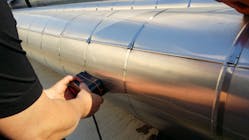When inspection engineers at a petrochemical plant were asked to find a solution for in-service inspection of insulated carbon steel pipes for flow-accelerated corrosion (FAC) and erosion, they turned to pulsed eddy current (PEC) technology.
FAC relates to the dissolution of the protective oxide layer on a metal surface as a result of fast-flowing fluids, resulting in metal loss. This type of corrosion commonly affects carbon steel piping, with the rate of FAC dependent on the velocity of the flow.
The inspection challenge
The pipes in question contained high-temperature, high-velocity fluids. FAC concerns were present on the inner surface of the pipes, particularly at the pipes’ articulated elbows and straps. Pipes were 318.5 millimeters (mm) in diameter with a wall thickness of 9.5 mm, and they were clad with 60 mm insulation and a 0.5 mm aluminum weather jacket.
A key factor in the inspection challenge was that the inspection had to be conducted in-situ without any damage to the insulation or aluminum cladding of the pipes.
The inspection method
PEC was used to test for FAC in this example because it is designed specifically to support the detection and assessment of Corrosion Under Insulation (CUI) and FAC.
The PEC system was chosen because it has a number of advantages over other methods and it enables accurate measurement of corrosion and wall thickness on the outer surface of pipes as well as on the inner surface of insulated pipes without the need for costly removal of any cladding or coverings.
The system is suitable for use on several materials including metal, aluminum, stainless steel and galvanized steel weather jackets. It provides real-time C-scan imaging, wall thickness measurements (inside diameter [ID] and outside diameter [OD] corrosion) and rapid data acquisition (up to 15 readings per second).
Carrying out the inspection
Inspections were carried out on two areas. The first was a straight section of insulated piping which was believed to have no corrosion or damage issues, and which was well away from any elbows, valves or junctions. The second test area was an elbow upstream along the same pipe where it was possible to hear the fluid rushing past as it accelerated around the bend.
The chosen PEC system is a rugged and portable instrument specially designed for harsh environments. It can operate on surfaces up to 120°C, which was an important consideration since the fluid in the pipes was extremely hot.
Inspections were carried out on two areas.
The system has a built-in encoder that was used to first scan the straight section. This dynamic scan mode enables continuous scanning (up to 75 mm/second). Testing revealed no significant wall loss.
When it came to testing the second section (the elbow), it was not possible to use the dynamic scan mode because of the irregular surface and sudden step changes of the aluminum weather jacket. To counteract this, the technicians mapped out a 50 mm x 50 mm grid on the surface of the elbow, which allowed them to move the probe from one grid location to the other, recording the positions as they went along. Even though this method results in a slightly lower resolution, it still produces highly accurate results and enables irregular surfaces to be scanned quickly and efficiently.
The results
The results confirmed substantial wall loss at the bend, but the inspectors were surprised to learn that the corrosion continued through the outermost curved surface (extrados) of the elbow. Without the ability of the PEC system to measure FAC on the uneven surface, this may not have been detected until it was too late — or it may have required costly removal of the cladding and insulation and consequently, downtime to carry out the inspection using other methods such as ultrasonic thickness testing.
The results confirmed substantial wall loss at the bend, but the inspectors were surprised to learn that the corrosion continued through the outermost curved surface (extrados) of the elbow.
Benefits of the PEC system included:
- More cost-effective than other methods
- Reduced inspection times
- Fast scanning — up to 75 mm/s
- Real-time, intuitive C-scan imaging, wall thickness measurements (ID and OD corrosion)
- Can scan and map irregular surfaces
- Automatic generation of detailed reports
- Multiple probe/accessory options
- Portable and lightweight (6.6 kilograms)
- Six- to eight-hour battery life
- Reduced operator dependence
Before the chosen PEC system was developed, technicians had to rely on other methods for measuring wall thickness without removing insulation, all of which had limitations.
Jason De Silveira is director at Nexxis and founder, director and company secretary of a specialist equipment rental and services company, Nexxis Pty Ltd. Over 18 years of experience in the oil & gas, mining and resources sectors — both domestic and international markets. His experience includes offshore and onshore projects working in Australia, Singapore, Thailand, Kuwait, Ghana and Dubai.
De Silveira has always had an interest in specialist engineering equipment utilized on oil & gas projects. His keen interest and technical ability in engineering practices and the use of the latest technical equipment, and natural entrepreneurial flair, was the driving motivator behind the inception of Nexxis Pty Ltd. In addition to personal pursuits in property development and investment, he recognized a gap in the specialist equipment rental and services market and, as a result, Nexxis Pty Ltd. was born. Nexxis Pty Ltd. is a rapidly growing, specialist equipment rental and service provider company that has quickly diversified into industries ancillary to oil & gas, and resources.
For more information on nondestructive testing programs, contact Nexxis at 08-8418-4952 or visit nexxis.com.au.




